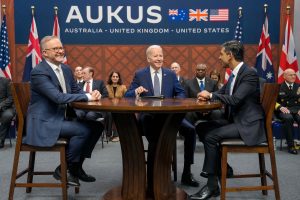Australia’s long and contentious journey toward the acquisition of nuclear-propelled submarines is a stark indicator of the rising anxiety in Canberra about China’s fast-paced military modernization and aspirations for regional primacy.
Australia believes its strategic circumstances have deteriorated to the point that it needs the speed, stealth, range, and strike capabilities that come with nuclear submarines.
That may be so, but Australia nonetheless has chosen an almost impossibly difficult path to walk. The plan announced in San Diego by AUKUS partners is ambitious, massively expensive, and laden with risk far exceeding anything Australia has attempted before.
There are many moving parts, but the core elements are threefold.
From around 2027, U.S. and U.K. nuclear submarines will undertake rotational deployments to Australia
In the 2030s, subject to U.S. Congressional approval, Australia will purchase three to five Virginia-class subs. The Biden administration and Australia itself are also making new investments in the United States’ submarine-building capacity.
Lastly, beginning from the early 2040s, Australia will build eight entirely new submarines, designed with the United Kingdom but featuring U.S. technology, including a new combat system. The “SSN AUKUS,” as it has been named, will be operated by both Australia and the United Kingdom.
In the decades it will take to deliver all of the planned submarines, Australian governments will face four intersecting challenges.
First, the Everest-like climb of delivering the submarines – acknowledged by the Australian government as “one of the greatest industrial endeavors Australia has ever undertaken” – presents a severe test, even with U.S. and U.K. help.
Before it can operate, let alone build, nuclear submarines, Australia needs a massive lift in its maritime workforce (everything from submariners to nuclear engineers to specialist welders) and military and industrial infrastructure.
The trilateral nature of the program and its phased approach give Australia a fighting chance: training and technical support from the United States and the United Kingdom is central to the AUKUS package. The United States will also have to get better at the transfer of defense technologies vital to the project, but which could get held up in labyrinthine regulatory controls.
The bill for the submarines – tentatively put at AU$268 billion to AU$368 billion (US$178-$245 billion) over several decades – will push defense spending well beyond 2 percent of GDP at a time when the national budget is in structural deficit and demands for spending on health and social welfare are high. Public support for such eye-watering levels of spending on a single capability could easily wane.
Second, Australian governments face the challenging task of preserving sovereignty and autonomy within the alliance, even as military cooperation moves beyond interoperability toward integration.
U.S. officials have been quick to say there is no quid pro quo to the submarine deal. Still, the problem for future Australian governments, if it ever arises, is likely to come in the form of expectation of how the submarines would be used, including in a Taiwan crisis, rather than a demand for operational control.
Australia will want this to be a sovereign decision, but the way in which the United States is so tightly wound into the submarine deal makes the already tight embrace of the alliance even tighter. This is a reality that is pointless to deny: it is simply another risk to manage.
Third, AUKUS and the broader goal of building an Australian Defense Force (ADF) with more offensive punch, along with balancing mechanisms like the Quad, will be hard to reconcile with the Australia’s goal of stabilizing ties with Beijing and restoring an economic relationship damaged by coercive Chinese trade action.
China regularly and vehemently voices its “strong opposition” to AUKUS and the nuclear submarine deal, arguing that together they “introduce bloc confrontation” into the Indo-Pacific and will stoke an arms race. President Xi Jinping recently hit out at what he called U.S.-led “encirclement and suppression.”
Beijing has also waged a relentless but so far unsuccessful war in the International Atomic Energy Agency against the transfer of nuclear propulsion technology to Australia, describing this as “flagrant proliferation” and a “serious violation” of the safeguards obligations of the three AUKUS parties.
Australian leaders will be bracing themselves for expressions of displeasure. An abrupt reversal of all recent progress in the relationship with Beijing is possible, but would seem less likely than targeted retaliation. We should also expect China to keep campaigning against the submarines in Southeast Asia and the broader Global South.
Fourth, Australia must continue to reassure regional neighbors, especially Indonesia, that the submarine program can be managed within Australia’s nuclear non-proliferation obligations and won’t contribute to a regional arms race.
The AUKUS submarine program is a dramatic punctuation mark in a much larger story of radical changes to the military balance in the Indo-Pacific driven by concerns about China’s assertive posture in the region and coercion of Taiwan.
The United States is shifting to a more distributed and mobile force posture and modernizing and strengthening alliances. Australia and Japan are boosting defense spending and aspire to militaries with much more offensive punch, especially long-range strike capabilities.
The goal is to build a U.S.-led arc of deterrence across the region, with Taiwan front of mind. But in the current era, allies like Australia and Japan are also sharply focused on defense of the homeland.
Southeast Asian nations worry about the risk of war in the Indo-Pacific, with its devastating strategic and economic consequences, and want the United States and China to better manage their competition.
The first Australian-operated Virginia-class submarine won’t enter into service until the mid-2030s. The first Australian-built submarine will have to wait for the 2040s. These immensely long lead times underline how strategic shifts can easily outpace the ability of governments to deliver the military capability to deal with them.
The biggest risk of Australia’s nuclear submarines, therefore, is the possibility they will still be on the drawing board when they are most needed.
































